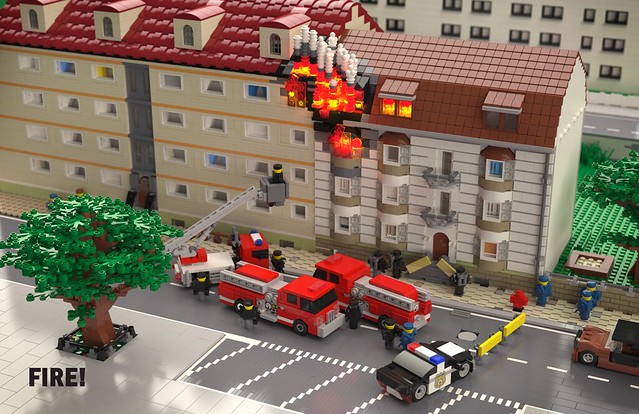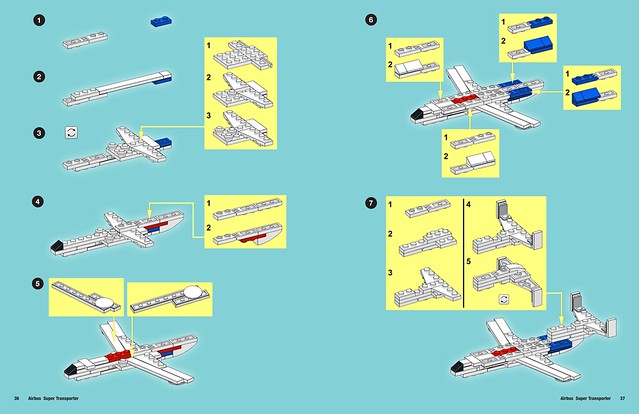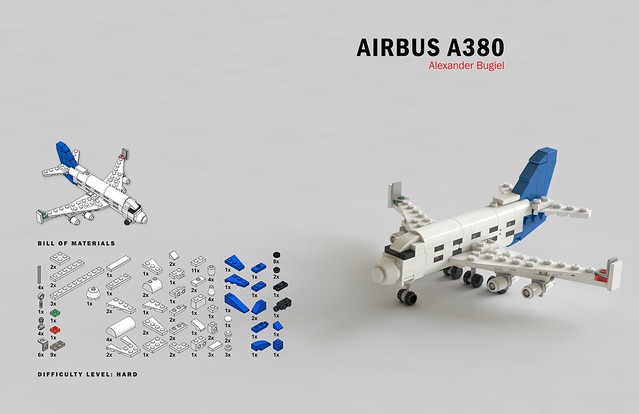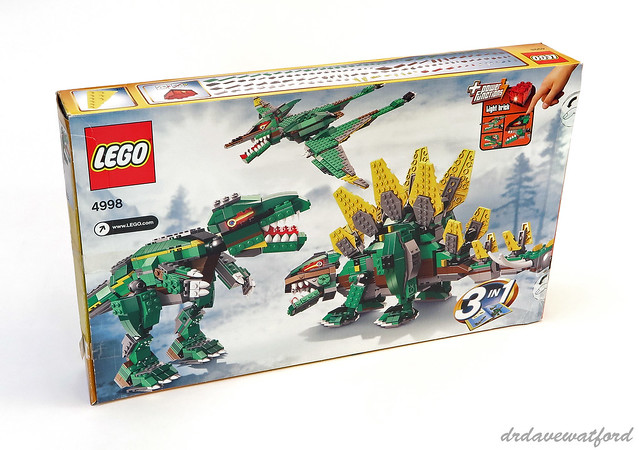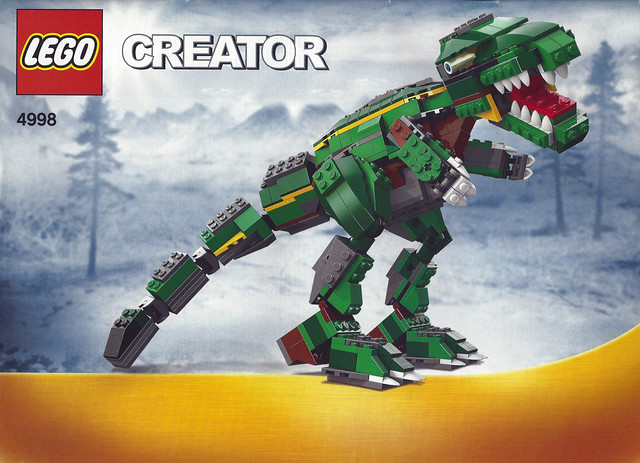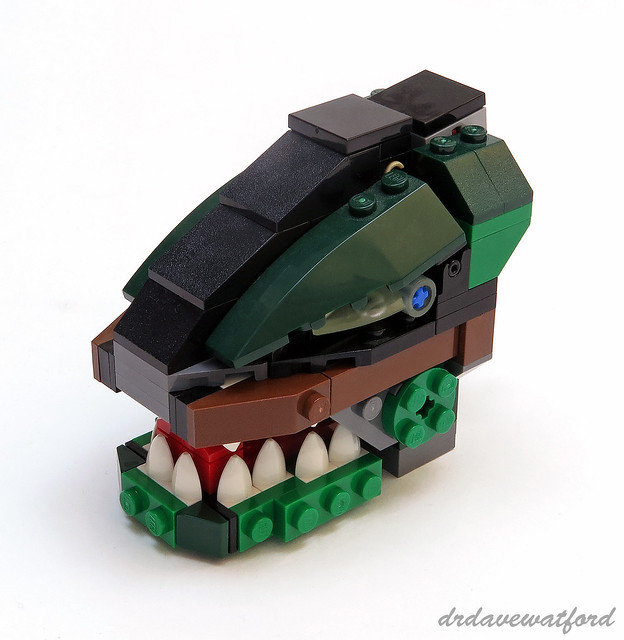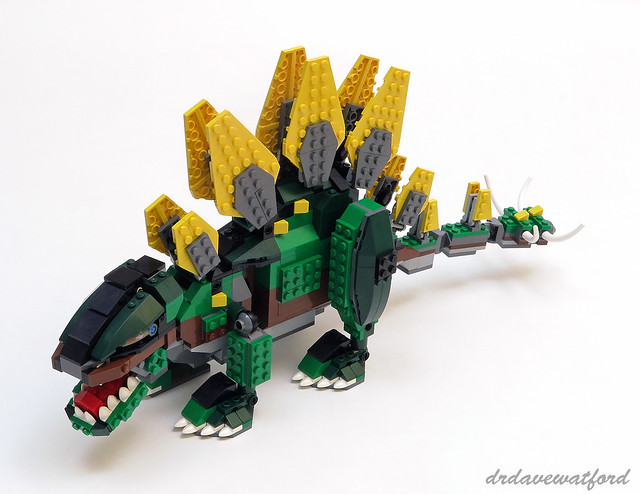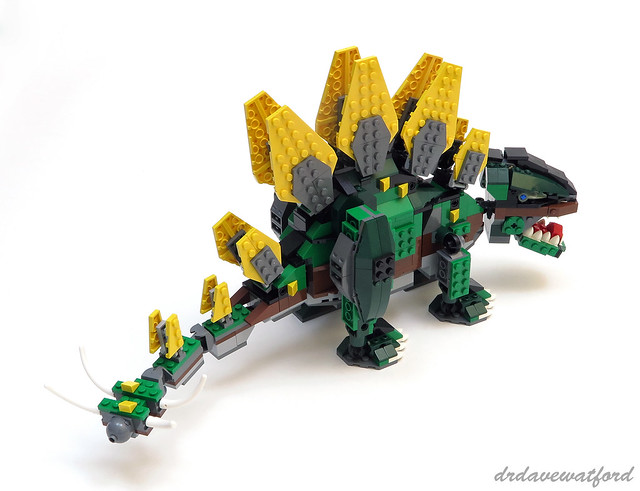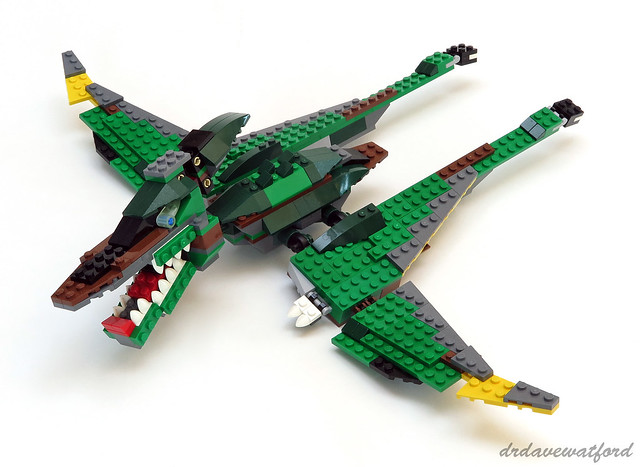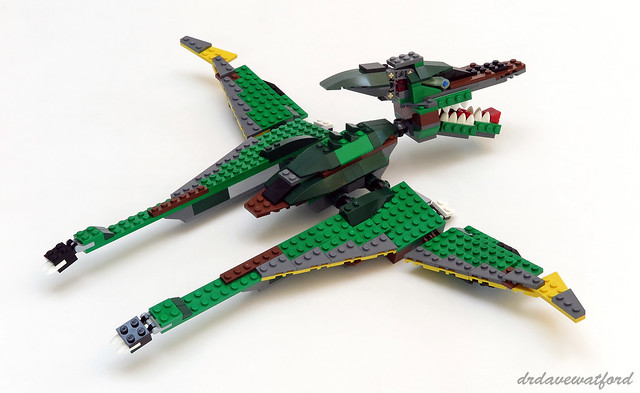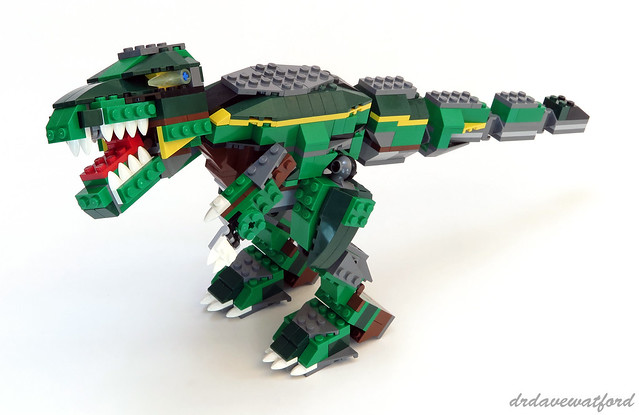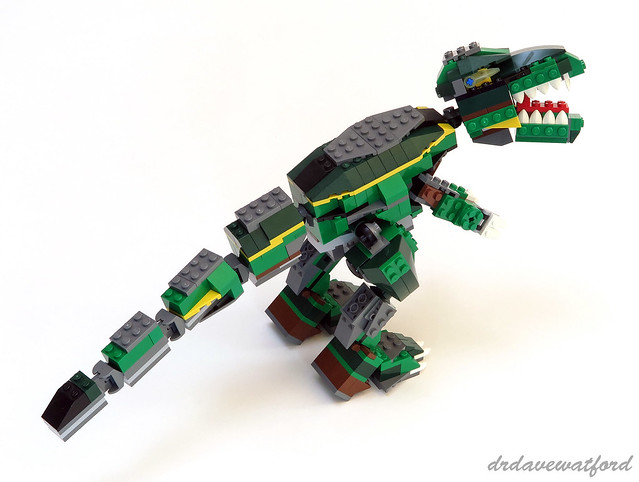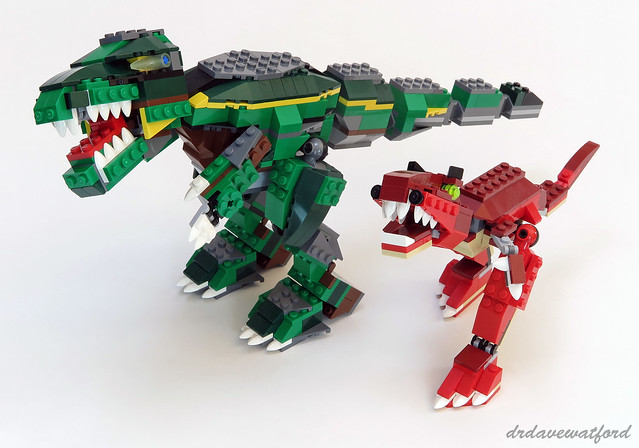I've previously reviewed and enjoyed a couple of books that Mattia Zamboni has been involved with, notably Amazing Vehicles and its sequel More Amazing Vehicles both of which he co-wrote with Nathanael Kuipers. When publisher No Starch Press got in touch to let me know that Mattia had a new book on the way, therefore, I was keen to take a look....
Mattia, a LEGO-loving graphic designer from Switzerland, has collaborated with contributors from around the globe to produce Tiny LEGO Wonders, a book which celebrates microscale models. The book's release is well-timed, with microscale seemingly firmly in fashion right now if the number of related magazine articles, books, official LEGO releases and MOCs is anything to go by. Each of the eleven contributors has submitted a number of microscale designs, making a total of forty designs in all which are showcased in the book.
The book is organised around ten themed chapters, each of which provides a suitable setting for a number of featured microscale builds. Each chapter kicks off with a two-page spread showing a brick-built microscale diorama, for example the scene above which illustrates the "Fire!" chapter, and the featured builds are suitably positioned within this diorama. These brick-built backdrops are generally superbly realised, and for me they're a real highlight of the book - a perfect reminder of the surprising level of detail that can be captured at this scale.
Each chapter showcases up to six themed microscale builds. First up we have "The Train Station" which includes three trains and a touring coach, followed by "The Airport", "Fire!" and so on. It's immediately evident that the featured builds, which include the Intercity Express above, are really quite impressive and of a consistently high quality. As you'll have noticed from the picture above, being showcased in the book doesn't just mean the inclusion of a couple of pretty photographs - each featured design is accompanied by an inventory of the elements needed to build it, and also a set of building instructions, thus allowing the reader to relatively easily reproduce the designs themselves.
The TGV Bullet Train above, which many LEGO fans will immediately recognise as a microscale version of an official LEGO set - 10233 Horizon Express - is one of my favourite builds featured in the book, although it's only one of many genuinely eye-catching designs on offer including a superb bulk carrier, a collection of excellent Formula 1 cars, a cracking little F-15 Eagle, a space shuttle plus crawler transporter, and many more. While the majority of builds are representations of real vehicles, the book does eventually deviate into fantasy territory with a number of sc-fi military vehicles featured in the final chapter, "The Moon Army". Overall, there's a nice varied selection of vehicles included in the book, although it's a crying shame that the scope doesn't extend to other types of models as well, for instance buildings, or perhaps even some of the environmental features which appear in the superb brick-built dioramas.
Before you can build anything you'll obviously have to accumulate the necessary elements and that's when things become tricky. Mattia's previous books featured designs which could all be built in their entirety using the elements contained in just one inexpensive Creator set, which I thought was an absolutely genius idea. In contrast, however, the elements needed to construct the 40 microscale builds in this book, or even just a couple of them, aren't to my knowledge readily available in a single set. Furthermore, my impression is that for many of the builds, some of the constituent elements probably aren't the kind that you're likely to have lying around in any quantity either, necessitating a visit to the likes of Bricklink. For the average AFOL that's probably not going to be a big deal, but for the more casual LEGO fan, sourcing the parts needed to build even the simplest of the models as designed could potentially be quite a challenge.
Looking beyond the actual content for a moment, I'm pleased to report that the book's presentation is up to the usual high standards that we've come to expect from No Starch Press. It sports a hard cover, and the quality of printing, photography and digital renders is excellent throughout the book's 200 pages. While I'm yet to attempt any of the builds myself, the instructions look to be clear and fairly easy to follow; although they lack the part callouts that LEGO routinely includes in building instructions these days, the builds are small and simple enough that this shouldn't be a problem for most builders.
In summary, Tiny LEGO Wonders is a beautifully presented book which is a pleasure to browse. It contains 40 microscale vehicle designs of consistently high quality, and the accompanying parts inventories and building instructions mean that readers can in theory attempt the builds for themselves. Furthermore, the book includes a number of delicious microscale backdrops within which the featured models are displayed, and to be honest if these fail to inspire then perhaps microscale building just isn't for you. On the downside, in contrast to the author's previous books which showcased models which could be built with the elements contained in just one inexpensive set, elements needed to construct the featured microscale builds here aren't to my knowledge available in a single set and would therefore likely have to be sourced from the likes of Bricklink which might put off less experienced builders. Also, it's disappointing that only vehicle designs are included in the book; the dioramas provide a tantalising glimpse of the kind of impressive structures and scenery that can be built at this scale, and it would have been great if parts inventories and instructions for a few non-vehicle builds had been included as well. All things considered, however, it's easy to recommend Tiny LEGO Wonders, and I'm looking forward to attempting a few of the builds myself....
Tiny LEGO Wonders will be available from the end of this month. At the time of writing, Amazon's UK site is quoting an RRP of £13.50 for the book which to me seems pretty good value for a 200-page hardback, especially as Amazon are slightly discounting the book; please use the Gimme LEGO affiliate link here to purchase if you're thinking of buying from Amazon in the UK. Amazon are also selling the book at a discount in the U.S., and you can find the link here.
Many thanks to Siobhan at No Starch Press for sending me a copy of the book to review on Gimme LEGO.
Monday, 25 July 2016
Wednesday, 13 July 2016
Dino-mite....
Regular readers of Gimme LEGO will know that I'm rather partial to a LEGO dinosaur, so when the chance recently arose for me to fill a gap in my LEGO dinosaur collection I quickly pounced. Set 4998 Stegosaurus was released back in 2008 just as I was emerging from my LEGO Dark Ages, and it disappeared from shelves the following year just as I was getting ready to buy it. Thanks to the wonders of eBay, however, it's now in my possession, albeit a few years later than originally planned....
One reason that I always intended to track this set down is that it's a Creator 3-in-1 offering and thus includes the parts and instructions to construct not just one but three different brick-built dinosaurs, although not all at the same time unfortunately. A large image of the headline Stegosaurus model takes pride of place on the front of the box (above), with the secondary pterodactyl and Tyrannosaurus rex builds relegated to small panels beneath. We're provided with large images of all three builds on the back of the box (below) together with a small panel top right which illustrates how the light brick included in the set is incorporated into the three models.
Despite my copy of the set being pre-owned the box has survived relatively unscathed, not least because the previous owner thankfully avoided opening the set using the thumb tabs provided. The set includes three substantial instruction booklets, with each dinosaur getting its own booklet; you can see the cover of the booklet containing the Tyrannosaurus rex instructions below. At 84 pages from cover to cover the booklet for the Stegosaurus is comfortably the longest. A variety of adverts are spread across the three booklets, and an inventory of parts contained within the set can be found in the pterodactyl instruction booklet.
Given that it's the headline build I decided to start with Stegosaurus. Construction begins with the head, and specifically the lower jaw which articulates with the rest of the head via a couple of hinge plates thus enabling the mouth to be opened. The light brick referred to on the front and back of the box is a 2 x 3 x 1 1/3 light brick containing a red LED and it's mounted in the middle of the head. It's a sobering thought that the real Stegosaurus, which could grow up to 9m in length and weigh over five tonnes, had a disproportionally small brain estimated to be not much bigger than the size of a walnut. So barely larger than a light brick then.... A small hinge mechanism covered with a couple of black 2 x 2 tiles is constructed towards the back of the head; when the rear-most tile is pressed the light brick illuminates, and if you're lucky the hinge mechanism sticks in the "on" position so that the light brick remains illuminated when you take your finger away; I'm not sure whether this is intentional or not, but it's welcome nonetheless. Despite the age of the set, and my copy being pre-owned, the light brick still works fine so the battery is obviously still viable - impressive. The eyes of the Stegosaurus consist of a pair of glow-in-the-dark Bionicle 1 x 3 teeth which can only be found in five sets in this colour; the eyes glow red when the light brick is illuminated. The top of the head is nicely contoured with dark green left and right 6 x 2 wedges which can be found in fewer than 10 sets in total.
The body of the Stegosaurus consists of two sections, with the smaller front body section next to be built. A dark green modified Technic 2 x 2 brick with rotation joint socket, which can only be found in six sets in this colour, is embedded on either side of this section and provides an attachment point for the front legs which will be built later, while the head attaches to another dark green modified Technic 2 x 2 brick with rotation joint socket embedded at the front, Once attached, the head can be angled left and right to around 45 degrees, and it can also rotate around its midline, but no up or down movement is possible. The foremost of Stegosaurus' characteristic bony dermal plates, which are represented by a variety of yellow wedge plates, are attached to the top of this section and are angled forward by way of a tilted modified 2 x 2 plate with pin holes. The larger, rear body section connects to the front section via 2 x 4 hinge plates with articulated joints which you can see here and here; while the two halves of the joint require an unexpectedly hard push to click together there's relatively little friction between the elements once connected so the joint moves very freely. Similar to the front body section, modified Technic 2 x 2 bricks with rotation joint socket are embedded on either side of the rear body section to provide an attachment point for the the hind legs, while three pairs of large dermal plates are mounted on the top of the rear section of the body and angled appropriately as you can see in the picture below.
With the body completed it's time to build the legs. While the hind legs are substantially larger than the front legs, all four feet are the same and all four legs articulate in a similar fashion, allowing a degree of flexion and extension at the shoulders and hips, and also some adduction and abduction in the case of the front legs in particular. Furthermore, each ankle incorporates a rare dark green Technic 2 x 2 brick with rotation joint half ball which has only ever appeared in three sets and which allows the feet to be rotated, flexed and extended at the ankles. More rare dark green elements make an appearance in the form of dark green 6 x 2 and 4 x 2 wedges which make up the thighs of the hind legs. Last to be built is a tail consisting of three distinct segments, two of which feature dermal plates on their upper surface. The tail segments are connected to each other and the rear body section using the same lax hinge joints that are used to connect the body sections together. Four tail spikes, represented by white dinosaur tail end sections, are mounted on the rearmost tail segment; this distinctive defensive arrangement has come to be known as a thagomizer which on a real Stegosaurus apparently included anything from four to ten spikes. The completed model is larger than I expected - more than 40 cm from nose to tail - and it looks quite impressive. That having been said, it should probably be acknowledged that LEGO has employed considerable artistic license from a design perspective - in reality, Stegosaurus was a herbivore and had small, peg-shaped teeth, so the modified 1 x 1 plates with tooth elements used to represent the teeth aren't a good representation of the real thing. Furthermore, the whole head is altogether too large and aggressive for this likely placid herbivore, and the arrangement of the bony plates is wrong as well - these were characteristically arranged in an alternating pattern down the dinosaur's back. Even so, it's a Creator 3-in-1 set we're talking about here rather than a UCS display set, and regardless of the inaccuracies the model is still immediately recognisable as a Stegosaurus and looks pretty good. Furthermore, the model can also be posed to some extent thanks to multiple articulation points, so not a bad effort overall.
And so to the first of the alternate builds, a pterodactyl. Once again the build commences with the head, which is huge in relation to the body, not to mention utterly terrifying.... The long, tooth-filled lower jaw is hinged at the back which allows the mouth to be opened. The light brick is once again incorporated into the head; it's activated by pressing down on the beast's cranial crest which projects upwards and backwards from the head. Once again a pair of glow-in-the-dark Bionicle 1 x 3 teeth represent the pterodactyl's eyes and glow red when the light brick is activated. The pterodactyl's body is tiny, and as was the case for the Stegosaurus the head is attached to the body by way of a rotation joint which allows the head to be angled left and right and also rotated around its midline.
The wings are comprised of three sections, the largest of which attach on either side of the body via a pair of rotation joints which allow the wings to be tilted upwards or downwards. The hind limbs are incorporated into the large wing sections, although in reality they would actually have emerged from the body; they project backwards and terminate in a pair of modified 1 x 1 plates with tooth. The mid-section of each wing attaches to the inner section via hinges comprising modified 1 x 2 plates which allow it to be angled upwards or downwards. The outermost wing section attaches to the rest of the wing by just one stud which allows it to be rotated forwards and backwards, and with the wings completed we're done. While the finished build is just about recognisable as a pterodactyl, it's not a great representation of the subject matter and it isn't going to win any design awards. Still, at least the head is suitably fearsome, and the model is certainly robust enough to swoosh if you're that way inclined, so it's not all bad I suppose.
The last of the three builds is a Tyrannosaurus Rex. Many aspects of the build predictably mirror what we've seen with the previous two models, including the hinged lower jaw and copious sharp teeth, the illuminating eyes, and the use of a rotation joint to attach the head to the body which enables the head to be angled left and right and also rotated around its midline.
At first glance the body looks a little undersized compared with the large head, but on the basis of artists impressions of Tyrannosaurus rex I think it's actually pretty much spot on. The tail is made up of four distinct sections joined together by the same 2 x 4 hinge plates with articulated joints that were used to create the Stegosaurus tail; such is the size and weight of the head relative to the body that only by attaching the tail can you stop the legless beast from toppling forward. The powerful legs are made up of a nunber of sections which are joined together in something approximating a zig-zag pattern via the use of rotation joints; although the arrangement looks a bit haphazard the legs actually do a pretty good job of supporting the weight of the rest of the model and also allow the beast to be posed to some extent. The puny arms are last to be built; they look rather blocky and untidy, but can at least be raised and lowered. Overall I really quite like the finished Tyrannosaurus rex - it's well proportioned, the head looks great, the multiple points of articulation offer some flexibility when displaying the model, and it even comes complete with a yellow go-faster stripe.....
This is just one of a number of brick-built tyrannosaurids that LEGO have produced over the years, with other examples to be found in Set 4507 Prehistoric Creatures and Set 6914 Prehistoric Hunters. As luck would have it I just so happen to have the latter built and on display at home, and you can see it alongside the completed Tyrannosaurus rex, which completely dwarfs it, in the picture below.
Over time I seem to be increasingly ambivalent about many of LEGO's licenced themes and their focus on minifigures at the expense of the actual builds. On the flipside, however, I'm increasingly relishing the generally simpler pleasures of the Creator theme, and I thoroughly enjoyed building this Creator 3-in-1 set. Sure, the models are relatively crude, but in addition to the enjoyable building experience I think that the Stegosaurus and Tyrannosaurus rex actually look pretty good, and I'll be keeping the latter assembled and on display for the time being I think.
One reason that I always intended to track this set down is that it's a Creator 3-in-1 offering and thus includes the parts and instructions to construct not just one but three different brick-built dinosaurs, although not all at the same time unfortunately. A large image of the headline Stegosaurus model takes pride of place on the front of the box (above), with the secondary pterodactyl and Tyrannosaurus rex builds relegated to small panels beneath. We're provided with large images of all three builds on the back of the box (below) together with a small panel top right which illustrates how the light brick included in the set is incorporated into the three models.
Despite my copy of the set being pre-owned the box has survived relatively unscathed, not least because the previous owner thankfully avoided opening the set using the thumb tabs provided. The set includes three substantial instruction booklets, with each dinosaur getting its own booklet; you can see the cover of the booklet containing the Tyrannosaurus rex instructions below. At 84 pages from cover to cover the booklet for the Stegosaurus is comfortably the longest. A variety of adverts are spread across the three booklets, and an inventory of parts contained within the set can be found in the pterodactyl instruction booklet.
Given that it's the headline build I decided to start with Stegosaurus. Construction begins with the head, and specifically the lower jaw which articulates with the rest of the head via a couple of hinge plates thus enabling the mouth to be opened. The light brick referred to on the front and back of the box is a 2 x 3 x 1 1/3 light brick containing a red LED and it's mounted in the middle of the head. It's a sobering thought that the real Stegosaurus, which could grow up to 9m in length and weigh over five tonnes, had a disproportionally small brain estimated to be not much bigger than the size of a walnut. So barely larger than a light brick then.... A small hinge mechanism covered with a couple of black 2 x 2 tiles is constructed towards the back of the head; when the rear-most tile is pressed the light brick illuminates, and if you're lucky the hinge mechanism sticks in the "on" position so that the light brick remains illuminated when you take your finger away; I'm not sure whether this is intentional or not, but it's welcome nonetheless. Despite the age of the set, and my copy being pre-owned, the light brick still works fine so the battery is obviously still viable - impressive. The eyes of the Stegosaurus consist of a pair of glow-in-the-dark Bionicle 1 x 3 teeth which can only be found in five sets in this colour; the eyes glow red when the light brick is illuminated. The top of the head is nicely contoured with dark green left and right 6 x 2 wedges which can be found in fewer than 10 sets in total.
The body of the Stegosaurus consists of two sections, with the smaller front body section next to be built. A dark green modified Technic 2 x 2 brick with rotation joint socket, which can only be found in six sets in this colour, is embedded on either side of this section and provides an attachment point for the front legs which will be built later, while the head attaches to another dark green modified Technic 2 x 2 brick with rotation joint socket embedded at the front, Once attached, the head can be angled left and right to around 45 degrees, and it can also rotate around its midline, but no up or down movement is possible. The foremost of Stegosaurus' characteristic bony dermal plates, which are represented by a variety of yellow wedge plates, are attached to the top of this section and are angled forward by way of a tilted modified 2 x 2 plate with pin holes. The larger, rear body section connects to the front section via 2 x 4 hinge plates with articulated joints which you can see here and here; while the two halves of the joint require an unexpectedly hard push to click together there's relatively little friction between the elements once connected so the joint moves very freely. Similar to the front body section, modified Technic 2 x 2 bricks with rotation joint socket are embedded on either side of the rear body section to provide an attachment point for the the hind legs, while three pairs of large dermal plates are mounted on the top of the rear section of the body and angled appropriately as you can see in the picture below.
With the body completed it's time to build the legs. While the hind legs are substantially larger than the front legs, all four feet are the same and all four legs articulate in a similar fashion, allowing a degree of flexion and extension at the shoulders and hips, and also some adduction and abduction in the case of the front legs in particular. Furthermore, each ankle incorporates a rare dark green Technic 2 x 2 brick with rotation joint half ball which has only ever appeared in three sets and which allows the feet to be rotated, flexed and extended at the ankles. More rare dark green elements make an appearance in the form of dark green 6 x 2 and 4 x 2 wedges which make up the thighs of the hind legs. Last to be built is a tail consisting of three distinct segments, two of which feature dermal plates on their upper surface. The tail segments are connected to each other and the rear body section using the same lax hinge joints that are used to connect the body sections together. Four tail spikes, represented by white dinosaur tail end sections, are mounted on the rearmost tail segment; this distinctive defensive arrangement has come to be known as a thagomizer which on a real Stegosaurus apparently included anything from four to ten spikes. The completed model is larger than I expected - more than 40 cm from nose to tail - and it looks quite impressive. That having been said, it should probably be acknowledged that LEGO has employed considerable artistic license from a design perspective - in reality, Stegosaurus was a herbivore and had small, peg-shaped teeth, so the modified 1 x 1 plates with tooth elements used to represent the teeth aren't a good representation of the real thing. Furthermore, the whole head is altogether too large and aggressive for this likely placid herbivore, and the arrangement of the bony plates is wrong as well - these were characteristically arranged in an alternating pattern down the dinosaur's back. Even so, it's a Creator 3-in-1 set we're talking about here rather than a UCS display set, and regardless of the inaccuracies the model is still immediately recognisable as a Stegosaurus and looks pretty good. Furthermore, the model can also be posed to some extent thanks to multiple articulation points, so not a bad effort overall.
And so to the first of the alternate builds, a pterodactyl. Once again the build commences with the head, which is huge in relation to the body, not to mention utterly terrifying.... The long, tooth-filled lower jaw is hinged at the back which allows the mouth to be opened. The light brick is once again incorporated into the head; it's activated by pressing down on the beast's cranial crest which projects upwards and backwards from the head. Once again a pair of glow-in-the-dark Bionicle 1 x 3 teeth represent the pterodactyl's eyes and glow red when the light brick is activated. The pterodactyl's body is tiny, and as was the case for the Stegosaurus the head is attached to the body by way of a rotation joint which allows the head to be angled left and right and also rotated around its midline.
The wings are comprised of three sections, the largest of which attach on either side of the body via a pair of rotation joints which allow the wings to be tilted upwards or downwards. The hind limbs are incorporated into the large wing sections, although in reality they would actually have emerged from the body; they project backwards and terminate in a pair of modified 1 x 1 plates with tooth. The mid-section of each wing attaches to the inner section via hinges comprising modified 1 x 2 plates which allow it to be angled upwards or downwards. The outermost wing section attaches to the rest of the wing by just one stud which allows it to be rotated forwards and backwards, and with the wings completed we're done. While the finished build is just about recognisable as a pterodactyl, it's not a great representation of the subject matter and it isn't going to win any design awards. Still, at least the head is suitably fearsome, and the model is certainly robust enough to swoosh if you're that way inclined, so it's not all bad I suppose.
The last of the three builds is a Tyrannosaurus Rex. Many aspects of the build predictably mirror what we've seen with the previous two models, including the hinged lower jaw and copious sharp teeth, the illuminating eyes, and the use of a rotation joint to attach the head to the body which enables the head to be angled left and right and also rotated around its midline.
At first glance the body looks a little undersized compared with the large head, but on the basis of artists impressions of Tyrannosaurus rex I think it's actually pretty much spot on. The tail is made up of four distinct sections joined together by the same 2 x 4 hinge plates with articulated joints that were used to create the Stegosaurus tail; such is the size and weight of the head relative to the body that only by attaching the tail can you stop the legless beast from toppling forward. The powerful legs are made up of a nunber of sections which are joined together in something approximating a zig-zag pattern via the use of rotation joints; although the arrangement looks a bit haphazard the legs actually do a pretty good job of supporting the weight of the rest of the model and also allow the beast to be posed to some extent. The puny arms are last to be built; they look rather blocky and untidy, but can at least be raised and lowered. Overall I really quite like the finished Tyrannosaurus rex - it's well proportioned, the head looks great, the multiple points of articulation offer some flexibility when displaying the model, and it even comes complete with a yellow go-faster stripe.....
This is just one of a number of brick-built tyrannosaurids that LEGO have produced over the years, with other examples to be found in Set 4507 Prehistoric Creatures and Set 6914 Prehistoric Hunters. As luck would have it I just so happen to have the latter built and on display at home, and you can see it alongside the completed Tyrannosaurus rex, which completely dwarfs it, in the picture below.
Over time I seem to be increasingly ambivalent about many of LEGO's licenced themes and their focus on minifigures at the expense of the actual builds. On the flipside, however, I'm increasingly relishing the generally simpler pleasures of the Creator theme, and I thoroughly enjoyed building this Creator 3-in-1 set. Sure, the models are relatively crude, but in addition to the enjoyable building experience I think that the Stegosaurus and Tyrannosaurus rex actually look pretty good, and I'll be keeping the latter assembled and on display for the time being I think.
Set 4998 Stegosaurus was released back in 2008 at a recommended retail price of £36.19 / US$49.99. Despite being retired from sale in 2009 the set can still be aquired relatively cheaply; my pre-owned, boxed, complete example of the set was recently purchased from eBay for less than £30, although if you're looking for a new, sealed copy then you'll pay upwards of £80 on Bricklink at time of writing.
Labels:
3-in-1,
4998,
Creator,
Dinosaur,
lego,
Pterodactyl,
Stegosaurus,
Tyrannosaurus Rex
Subscribe to:
Posts (Atom)


